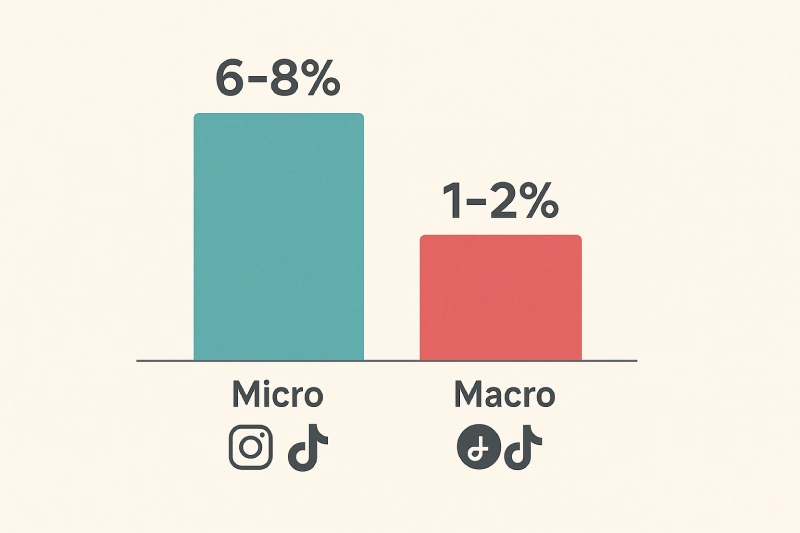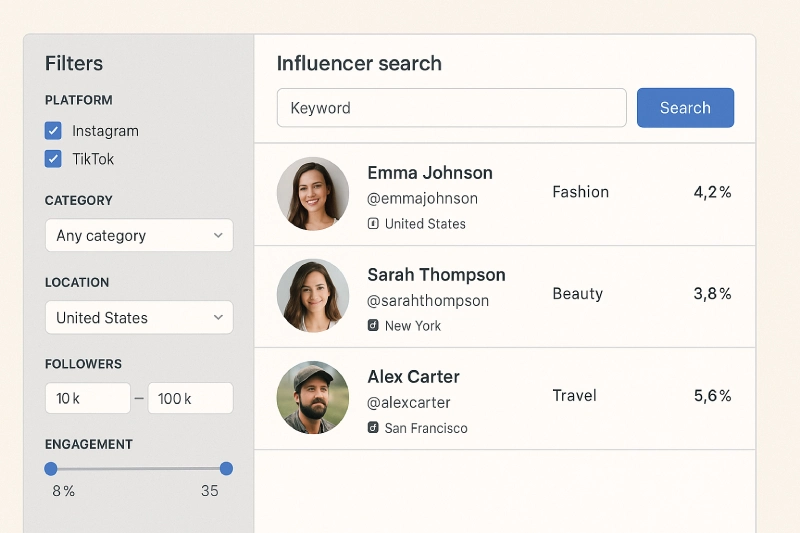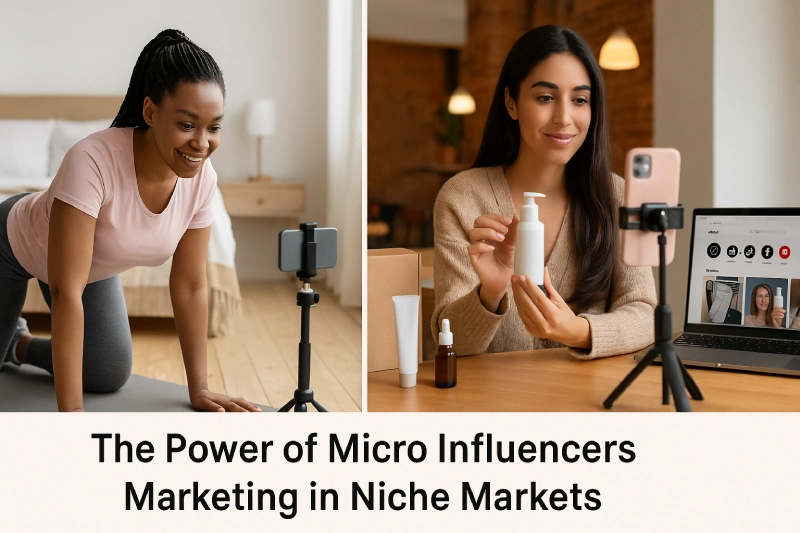In 2025, micro influencers marketing is no longer just a trend—it’s a core strategy for brands targeting engaged, niche audiences without blowing through massive ad budgets. Whether you’re in B2B or B2C, working with micro-influencers is now one of the most effective ways to build trust, spark conversations, and drive real-world conversions.
Unlike flashy celebrity endorsements or expensive macro-influencer campaigns, micro influencers marketing focuses on smaller creators—those with roughly 1,000 to 100,000 followers—who have deeply loyal followings. These creators might be fitness coaches on Instagram, sustainable lifestyle vloggers on YouTube Shorts, or even niche travel storytellers sharing tips on TikTok.
So why are so many brands, from eco-product startups to travel tech platforms, shifting toward this strategy? Simple: it works. In an era where authenticity and peer recommendations carry more weight than polished ads, micro influencers deliver unmatched engagement and relatability—often at a fraction of the cost.
💡 What is Micro Influencers Marketing?
Micro influencers marketing refers to the strategic collaboration between brands and creators with modest but highly engaged audiences, usually between 1,000 to 100,000 followers. These influencers operate in focused niches—like organic skincare, minimalist travel, tech gadgets, or even B2B SaaS tools—where their opinions hold significant sway.
Unlike macro influencers who appeal to the masses, micro influencers speak directly to their tribe. Their recommendations come across as authentic advice from a friend rather than a sales pitch. This makes them ideal for brands that want to reach real people in real communities—whether that’s through a review on Instagram, a how-to video on YouTube Shorts, or a mini product tour on LinkedIn.
In 2025, businesses across industries are doubling down on micro influencers marketing because it offers deeper relationships, better ROI, and localized influence—especially in competitive niche markets where trust matters most.
💥 Why Micro-Influencers Outperform Macro Influencers in Niche Markets
When it comes to micro influencers marketing, one thing is clear: small is powerful. While macro-influencers may have massive followings, micro-influencers consistently outperform them in the areas that matter most—engagement, trust, and cost-effectiveness.
🔥 Engagement Rates That Beat the Algorithm
Micro-influencers often boast 60% higher engagement rates than macro-influencers. Why? Their followers actually care. The conversations are real, the comments are thoughtful, and the content feels less like an ad and more like a recommendation from a friend.
- Instagram influencers with <25K followers get an average 7% engagement rate vs. 1.7% for macro creators (Source: Later, 2024)
- TikTok creators under 50K followers see 2–3x more interaction per post compared to their larger counterparts
💡 Case in Point:
A sustainable skincare brand, GlowGreen, partnered with 50 eco-lifestyle influencers under 20K followers. Their combined content reached 2.4M views—with 15K saves and a 38% click-through rate to the product page. That’s micro influencers marketing in action.
🤝 Trust & Community Building
Followers of micro-influencers often see them as peers, not celebrities. That closeness translates into authentic influence.
- Recommendations feel more like advice, not sponsorships
- They reply to DMs, engage in comments, and foster real conversations
- Communities form around shared values, making brand alignment easier
For niche markets—like vegan snacks, indie fashion, or B2B tools—this peer-to-peer influence is gold.
💸 Affordability That Scales
Let’s be honest—macro-influencers cost a fortune. With micro-influencers, you can often launch campaigns with 10–20 creators for the cost of one celebrity post.
- Many accept product collaborations or performance-based deals
- Lower risk, higher flexibility, and the ability to test different niches
- Scalable outreach without burning your entire budget
💬 “Working with micro-influencers allowed us to test five different markets in a single month—something we couldn’t afford with a single macro campaign.” – D2C Founder, Apparel Brand
📈 How Micro Influencers Marketing Drives Real Conversions
While reach and visibility are great, let’s talk results. The biggest reason brands are adopting micro influencers marketing strategies is because it drives actual sales, app downloads, and signups.
✅ It Shortens the Customer Journey
Micro-influencers operate within tight communities. That means:
- Fewer touchpoints from discovery to purchase
- More DMs like “Where can I buy this?” and fewer passive likes
- Real-time product walkthroughs, live Q&As, and link-in-bio shoppable content
🛍️ A travel brand reported 3x more bookings from 15 YouTube Shorts creators than a large-scale Google Ads campaign—thanks to storytelling, trust, and tailored audience reach.
📊 More Actionable, Trackable ROI
- Use promo codes, UTM links, and affiliate dashboards to measure results
- Compare CTR, conversion rates, and cost-per-acquisition
- Repurpose influencer content across your own ads, landing pages, and emails
“We saw a 25% lower CPA using micro influencers on Instagram vs. our Meta Ads campaign.” – Ecom Head, Wellness Brand
In a crowded market, micro influencers marketing doesn’t just create buzz—it moves the needle on conversions and customer loyalty.
🎯 Identifying the Right Micro-Influencers for Your Brand
One of the most important parts of micro influencers marketing is selecting the right creators—those whose content, audience, and personality align with your brand.
🔍 Tools to Find Niche Influencers
Start with platforms designed for influencer discovery:
- Heepsy – Filter by niche, location, platform, and engagement rate
- BuzzSumo – Great for identifying top sharers and bloggers in niche topics
- Modash – Ideal for Instagram and TikTok micro influencers with detailed analytics
- Bonus: Use LinkedIn for B2B creators and Reddit for community-driven voices
These tools help you go beyond follower count—letting you analyze audience quality, location, and brand-fit.
🎯 Filtering by Niche & Engagement
Not every influencer fits every brand. Here’s how to narrow it down:
- Look for creators whose content themes match your niche (e.g., eco-living, SaaS productivity, solo travel)
- Check engagement rate: Aim for 3%+ for creators under 50K followers
- Dive into comment sections: Are their followers real, asking questions, and interacting?
💬 Content Alignment & Messaging
Even if the numbers look good, content tone and values matter most.
- Do they share your brand’s mission or tone (fun, professional, bold, minimalist)?
- How do they talk to their audience? Is it salesy or storytelling-based?
- Look at their previous brand partnerships—do they feel authentic or forced?
Remember, the foundation of micro influencers marketing is trust—so their storytelling style should blend with your brand, not clash with it.
🛠️ Micro Influencers Marketing Strategy – Step by Step

Once you’ve found your dream influencers, it’s time to build a strategy that works. Here’s a simple step-by-step framework to follow:
✅ Step 1: Define Campaign Goals
Start by getting clear on what you want:
- Brand awareness?
- Sales and conversions?
- UGC for future ads?
Set 1–2 primary KPIs so everything stays focused.
✅ Step 2: Build Your Influencer List
Use the tools above or social platforms manually to create a shortlist. Include:
- Name + handle
- Follower count
- Niche
- Sample post
- Engagement rate
✅ Pro Tip: Use Google Sheets or Notion to organize and update this as your campaign scales.
✅ Step 3: Outreach with a Personal Touch
Skip the generic DM. Here’s a proven outreach message you can adapt:
Hi [Name],
I love your content—especially your recent post about [Topic]. I’m with [Your Brand], and we’re launching a new campaign that fits your audience perfectly. Would you be open to a quick collab?Happy to send more details!
– [Your Name]
Micro influencers marketing is all about genuine connections—so make your message feel real, not robotic.
✅ Step 4: Track ROI & Engagement
- Use UTM links, coupon codes, or affiliate dashboards
- Monitor reach, saves, click-throughs, and actual sales
- Keep notes: Who performed best? Who got reshared? Who overdelivered?
📊 The data you gather now will power your next round of influencer collaborations—and help you scale your micro influencers marketing strategy efficiently.
🌟 Real-World Brand Examples Using Micro-Influencers
Many iconic brands have cracked the code on micro influencers marketing by focusing on authenticity over celebrity hype. Here are a few standout success stories:

💄 Glossier
Glossier built its cult following not through A-list celebs, but by empowering everyday beauty lovers to share their skincare routines.
- Collaborated with 500+ micro influencers across YouTube and Instagram
- Result: Over 70% of traffic came from unpaid, community-driven content
🏠 Airbnb Local Hosts
Airbnb tapped local micro-influencers to showcase stays, city guides, and hidden gems.
- Example: A Mumbai-based creator with 15K followers generated 4,200 clicks in 72 hours just by posting Stories of their weekend stay
- Boosted regional bookings without paid ads
🏋️♂️ D2C Fitness Brands (like Gymshark)
Gymshark and other fitness brands have scaled global growth using fitness micro influencers.
- Their #Gymshark66 campaign featured 66 influencers under 50K followers
- Results: 10M+ combined views, 25K+ user-generated challenge videos, and viral reach with minimal spend
These brands prove that micro influencers marketing works best when you focus on community, consistency, and creative freedom.
💡 Final Thoughts
As you build your influencer campaigns, keep these tips top of mind:
- ✅ Relatability > Reach – Choose creators who “get” your audience
- ✅ Don’t over-script – Let influencers speak in their authentic voice
- ✅ Track engagement, not just views – Saves, replies, shares, and UGC matter more than vanity metrics
In 2025, micro influencers marketing is one of the smartest ways to grow fast and connect deeply—especially in niche markets where trust drives conversions.
FAQs
1. What is micro influencers marketing?
It’s a strategy that uses influencers with 1K–100K followers to promote brands in a more authentic and targeted way.
2. Which platforms work best for micro-influencers?
Instagram, TikTok, YouTube Shorts for B2C; LinkedIn and niche forums like Reddit for B2B.
3. How many followers is considered “micro”?
Typically between 1,000 and 100,000 followers—though engagement rate is more important than just numbers.
4. Is micro influencer marketing worth it for small businesses?
Absolutely. It’s budget-friendly, offers higher engagement, and helps small brands reach local or niche audiences effectively.
5. How to measure success in micro influencers campaigns?
Track link clicks, promo code usage, conversions, and content engagement (likes, saves, comments, shares).
6. Can B2B brands use micro influencers?
Yes! Thought leaders, consultants, and niche LinkedIn creators are powerful in B2B micro influencers marketing.




